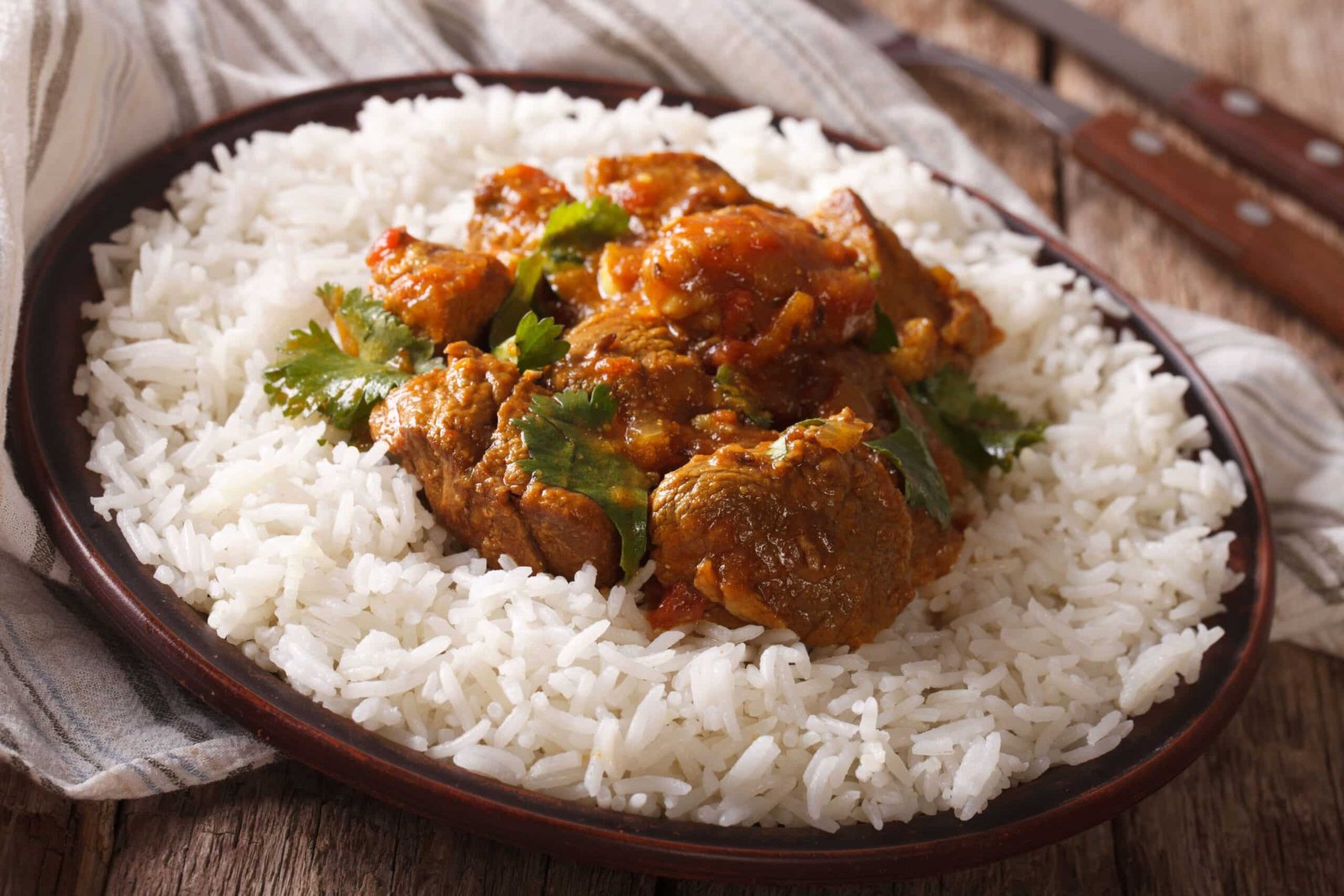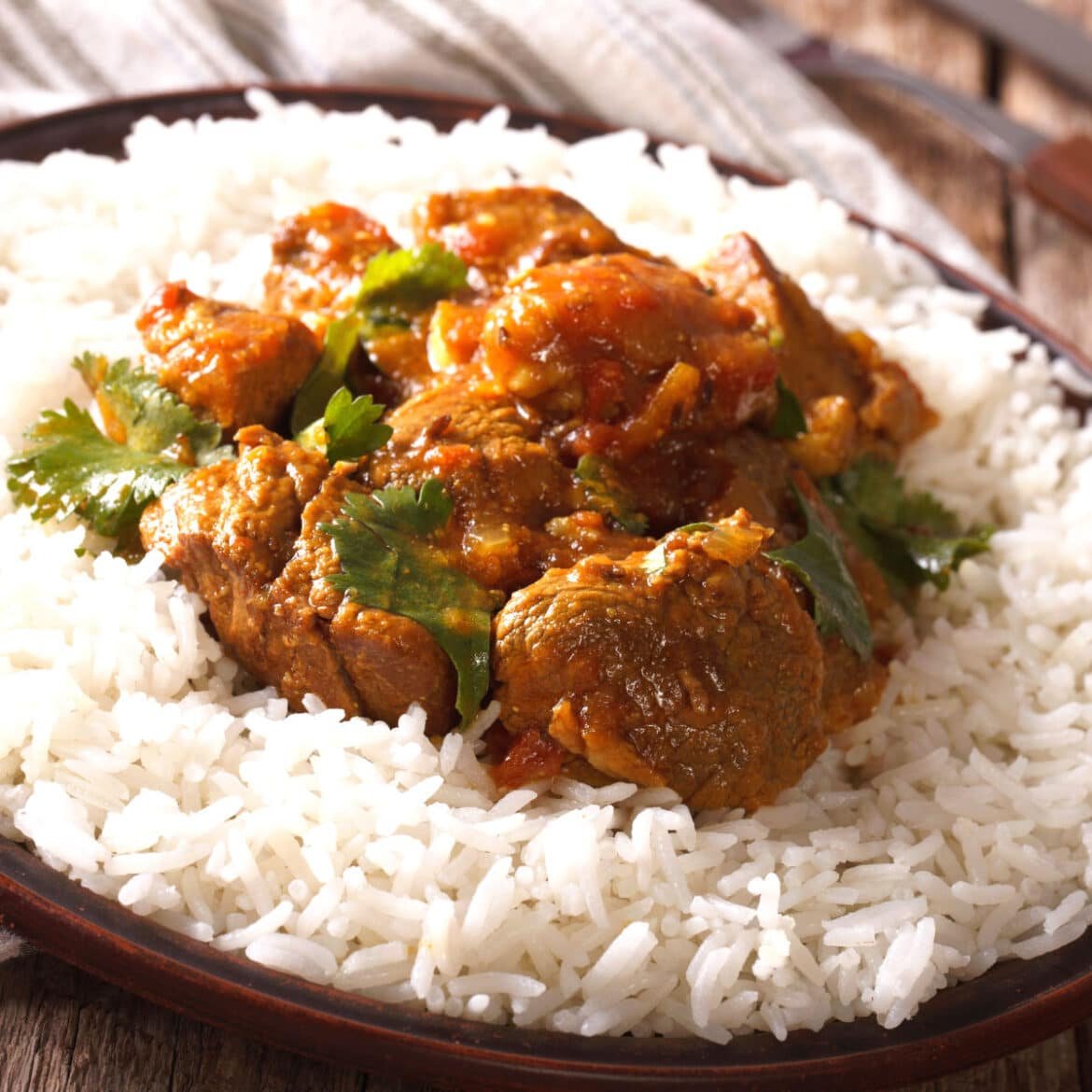Discover the authentic flavors of Madras curry with our easy-to-follow Madras curry recipe. Make restaurant-quality curry at home today!
What is a madras curry?
Madras curry is a type of curry that is often associated with the cuisine of South India, particularly the city of Chennai (formerly known as Madras), which is located in the southern state of Tamil Nadu. It’s known for its bold and spicy flavors.
Key characteristics of Madras curry typically include:
- Spiciness: Madras curry is known for its heat. It often contains a significant amount of chili peppers, which gives it its characteristic spiciness. The level of heat can vary depending on personal preferences, but it’s generally considered to be quite spicy.
- Rich Tomato Base: Many Madras curry recipes use a tomato-based sauce or gravy. Tomatoes are often cooked down to create a thick and flavorful base for the curry.
- Blend of Spices: A mixture of spices is used to create the complex flavor profile of Madras curry. Common spices include cumin, coriander, turmeric, mustard seeds, fenugreek, and curry leaves. These spices are toasted or sautéed to release their flavors before being added to the curry.
- Meat or Vegetables: Madras curry can be made with a variety of main ingredients, including chicken, lamb, fish, shrimp, or vegetables. It’s versatile and can be adapted to suit different dietary preferences.
- Coconut Milk: While not always included, some versions of Madras curry incorporate coconut milk or coconut cream to add a creamy and slightly sweet element to the dish.
- Serving: Madras curry is typically served with rice or Indian bread such as naan or roti.

What is the difference between madras curry and regular curry?
The term “curry” is quite broad and can encompass a wide range of dishes and flavors from various regions of the world, including India. Madras curry is a specific type of curry that originates from the southern region of India, particularly Chennai (formerly known as Madras). Here are some key differences between Madras curry and what might be considered a more “regular” or generic curry:
- Spiciness: Madras curry is known for its significant heat and spiciness. It often contains a substantial amount of chili peppers or chili powder. In contrast, a “regular” or generic curry can vary widely in terms of spiciness, and it might be milder or less spicy than a Madras curry. The level of spiciness in a curry can be adjusted based on personal preferences.
- Ingredients: Madras curry typically features a distinctive blend of spices that can include ingredients like cumin, coriander, turmeric, mustard seeds, fenugreek, and curry leaves. While these spices are also used in many other types of curry, the specific combination and proportions can vary. “Regular” curry can encompass a wide range of spice blends and ingredients, making it a more general term.
- Region: Madras curry is associated with the cuisine of South India, particularly Chennai and the Tamil Nadu region. Different regions in India have their own unique styles and flavors of curry, so a “regular” curry might refer to a dish from a different region with its own distinct characteristics.
- Base: Madras curry often has a tomato-based sauce or gravy, which contributes to its rich and tangy flavor. In contrast, other curries might use yogurt, coconut milk, or other bases to create their sauces, resulting in different taste profiles.
- Protein or Vegetables: Both Madras curry and other curries can be made with a variety of main ingredients, including chicken, lamb, fish, shrimp, vegetables, or legumes. The choice of main ingredient can affect the flavor and texture of the dish.
- Serving: Madras curry is typically served with rice or Indian bread like naan or roti. Other curries can be served in similar ways, but the specific accompaniments can vary.

Best Madras Curry Recipe
Ingredients:
For the Spice Blend:
- 2 tablespoons coriander seeds
- 1 tablespoon cumin seeds
- 1 teaspoon black peppercorns
- 1 teaspoon mustard seeds
- 1 teaspoon fenugreek seeds
- 4-6 dried red chilies (adjust to your spice preference)
For the Curry:
- 2 tablespoons vegetable oil
- 1 large onion, finely chopped
- 4 cloves garlic, minced
- 1-inch piece of fresh ginger, grated
- 2-3 green chilies, slit lengthwise (adjust to your spice preference)
- 2 teaspoons ground turmeric
- 2 teaspoons paprika
- 2 teaspoons garam masala
- 1 can (14 ounces) diced tomatoes
- 1 lb (450g) boneless chicken, lamb, or vegetables (your choice), cut into bite-sized pieces
- Salt to taste
- Fresh cilantro leaves, for garnish
- Cooked basmati rice or naan bread, for serving
Instructions:
- Prepare the Spice Blend:
- In a dry pan, toast the coriander seeds, cumin seeds, black peppercorns, mustard seeds, fenugreek seeds, and dried red chilies over low heat until fragrant. This should take about 2-3 minutes. Stir continuously to avoid burning.
- Let the toasted spices cool, then grind them into a fine powder using a spice grinder or mortar and pestle. This is your Madras curry spice blend.
- Heat the Oil:
- In a large, heavy-bottomed skillet or pan, heat 2 tablespoons of vegetable oil over medium-high heat.
- Sauté the Aromatics:
- Add the chopped onion and sauté until it becomes soft and translucent, about 5 minutes.
- Stir in the minced garlic, grated ginger, and green chilies, and sauté for an additional 2 minutes until fragrant.
- Add the Spice Blend:
- Sprinkle the ground turmeric, paprika, and garam masala over the onion mixture. Cook for 1-2 minutes, stirring constantly, until the spices release their aromas.
- Introduce the Protein/Vegetables:
- Add your choice of protein or vegetables to the pan (chicken, lamb, or vegetables). Cook for about 5-7 minutes until the meat is browned or the vegetables are slightly tender.
- Incorporate the Tomatoes:
- Pour in the diced tomatoes (with their juice) and simmer for another 10 minutes, allowing the flavors to meld together.
- Add the Spice Kick:
- Stir in 2-3 teaspoons of your Madras curry spice blend, adjusting to your desired level of spiciness. Remember, Madras curry is known for its heat, so go bold or mild as you like.
- Simmer to Perfection:
- Reduce the heat to low, cover the pan, and let the curry simmer for 20-25 minutes. This will allow the flavors to intensify and the sauce to thicken.
- Garnish and Serve:
- Before serving, season with salt to taste and garnish with fresh cilantro leaves.
- Serve your Authentic Madras Curry with steamed basmati rice or warm naan bread, and enjoy the spicy, aromatic journey to South India!
Would you like to join our Pinterest page, where many delicious and simple recipes are shared every day?

Ingredients
- For the Spice Blend:
- 2 tablespoons coriander seeds
- 1 tablespoon cumin seeds
- 1 teaspoon black peppercorns
- 1 teaspoon mustard seeds
- 1 teaspoon fenugreek seeds
- 4-6 dried red chilies (adjust to your spice preference)
- For the Curry:
- 2 tablespoons vegetable oil
- 1 large onion, finely chopped
- 4 cloves garlic, minced
- 1-inch piece of fresh ginger, grated
- 2-3 green chilies, slit lengthwise (adjust to your spice preference)
- 2 teaspoons ground turmeric
- 2 teaspoons paprika
- 2 teaspoons garam masala
- 1 can (14 ounces) diced tomatoes
- 1 lb (450g) boneless chicken, lamb, or vegetables (your choice), cut into bite-sized pieces
- Salt to taste
- Fresh cilantro leaves, for garnish
- Cooked basmati rice or naan bread, for serving
Instructions
- Prepare the Spice Blend:
- In a dry pan, toast the coriander seeds, cumin seeds, black peppercorns, mustard seeds, fenugreek seeds, and dried red chilies over low heat until fragrant. This should take about 2-3 minutes. Stir continuously to avoid burning.
- Let the toasted spices cool, then grind them into a fine powder using a spice grinder or mortar and pestle. This is your Madras curry spice blend.
- Heat the Oil:
- In a large, heavy-bottomed skillet or pan, heat 2 tablespoons of vegetable oil over medium-high heat.
- Sauté the Aromatics:
- Add the chopped onion and sauté until it becomes soft and translucent, about 5 minutes.
- Stir in the minced garlic, grated ginger, and green chilies, and sauté for an additional 2 minutes until fragrant.
- Add the Spice Blend:
- Sprinkle the ground turmeric, paprika, and garam masala over the onion mixture. Cook for 1-2 minutes, stirring constantly, until the spices release their aromas.
- Introduce the Protein/Vegetables:
- Add your choice of protein or vegetables to the pan (chicken, lamb, or vegetables). Cook for about 5-7 minutes until the meat is browned or the vegetables are slightly tender.
- Incorporate the Tomatoes:
- Pour in the diced tomatoes (with their juice) and simmer for another 10 minutes, allowing the flavors to meld together.
- Add the Spice Kick:
- Stir in 2-3 teaspoons of your Madras curry spice blend, adjusting to your desired level of spiciness. Remember, Madras curry is known for its heat, so go bold or mild as you like.
- Simmer to Perfection:
- Reduce the heat to low, cover the pan, and let the curry simmer for 20-25 minutes. This will allow the flavors to intensify and the sauce to thicken.
- Garnish and Serve:
- Before serving, season with salt to taste and garnish with fresh cilantro leaves.
- Serve your Authentic Madras Curry with steamed basmati rice or warm naan bread, and enjoy the spicy, aromatic journey to South India!
If you like our recipe, would you please support us by sharing it?

